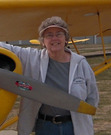Sarah Byrn Rickman's Blog, page 2
February 10, 2023
GROWING UP IN WORLD WAR II
January 26, 1998, I stood overlooking the watery grave of the USS Arizona, sunk during the Japanese surprise attack on Pearl Harbor, Hawaii, December 7, 1941. President Roosevelt called it “the date which will live in infamy.” World War II had caught up with America.
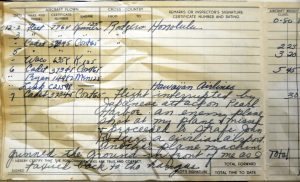 Logbook entry from Cornelia Fort, flight instructor, in the air over Pearl Harbor, December 7, 1941. Photo, Christopher Miller; Texas Woman’s University collection.
Logbook entry from Cornelia Fort, flight instructor, in the air over Pearl Harbor, December 7, 1941. Photo, Christopher Miller; Texas Woman’s University collection.In 1941, I was four years old. I have no memory of “Pearl Harbor Day.” I do know our family of three was enroute from Colorado, on our way to a family Christmas in Tennessee. My parents heard the news over our car radio. I learned that we were at war, whatever that was.
January 1942, I heard Kate Smith sing God Bless America on the radio for the first of many times. I’ve never forgotten it. That song brought hope to our shell-shocked nation that winter and still works its magic today.
‘NOTHIN’ CAN STOP THE ARMY AIR CORPS’
I well remember the patriotic wartime programs in the 4th floor auditorium at Denver’s Stevens Elementary School. Several boys, cardboard airplane wings strapped to their arms, zoomed around the stage while the student body – kindergarten through sixth grade – sang “Nothin’ Can Stop the Army Air Corps”. The phrase “Remember Pearl Harbor!” was instilled in us early on and via the radio we learned to sing Praise the Lord and Pass the Ammunition! Weekly, we brought a quarter to school to buy 25-cent Victory stamps to fill our War Bond books. In ten years, an $18.75 Series E war bond would be worth $25!!!
D-Day, the 6th of June 1944, changed the direction of The War. That day, the Allies landed on the beaches at Normandy, France. – It was the beginning of the end of WWII. It still took another year-plus.
President Franklin Delano Roosevelt died on April 12, 1945. He had led us. Now he was gone. But in May, Germany surrendered! In August, two atomic bombs shocked the world into a new reality and brought the Empire of Japan to its knees. August 14, 1945, the Japanese surrendered. It was over. My friends and I marched up and down the sidewalk along 6th Avenue in East Denver, banging our mothers’ pots and pans with spoons and shouting to the people riding the Number 6 streetcars home from work: “The War’s Over, the War’s Over!”
OLD GLORY FLIES HIGHAfter the war, now in 6th grade, I did my stint with the school Color Guard. At 3:15 in the afternoon, seven of us marched single file to the flagpole. Standing tall – saluting properly – slowly, reverently, we lowered and folded the precious Stars and Stripes. Since then, how many times have I stood in a major league baseball park and – hand over my heart – sung, with pride, the Star Spangled Banner while Old Glory made its way up the flagpole in center field?!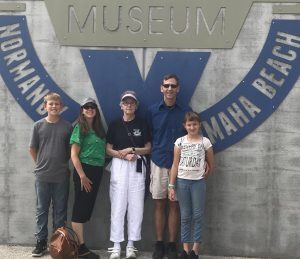
On that January 1998 day at Pearl Harbor I realized that having now seen where WWII began – the event that shaped my young life – I HAD to see where the beginning of the end of that war began. August 18, 2022, my older son, daughter-in-law, two grandchildren, and I visited the Overlord D-Day Museum, then walked the beach and the American cemetery in Normandy, France – hallowed ground where, today, our fallen troops lie quietly.
WHERE THE WWII REALITY BEGAN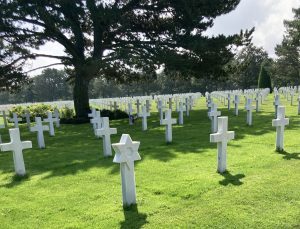 The U.S. cemetery at Normandy. Author photo
The U.S. cemetery at Normandy. Author photoPristine. Row and row and row upon row of white markers – the occasional Star of David standing among the crosses. Though crowds walk continually along the cemetery’s tree-lined path, the quiet is broken only by the occasional child’s cry amidst the soft murmurs of adult voices. This is where the reality began – and remains today.
Ahead lies a tall, slender monument. Inside is a chapel erected by the United States of America with this inscription:
“In grateful memory of her sons who gave their lives in the landings on the Normandy Beaches and in the liberation of Northern France. Their graves are the permanent and visible symbol of their heroic devotion and their sacrifice in the common cause of humanity.”
These words grace the altar:
I GIVE UNTO THEM ETERNAL LIFE AND THEY SHALL NEVER PERISH
Irving Berlin wrote it; Kate Smith sang it: God Bless America.
The post GROWING UP IN WORLD WAR II first appeared on Sarah Byrn Rickman.
January 6, 2023
WAFS Dorothy Fulton in NJ Hall of Fame
Dorothy Fulton, one of the original WAFS – Women’s Auxiliary Ferrying Squadron, World War II, later to be known as WASP – was inducted into the New Jersey Aviation Hall of Fame, November 3, 2022.
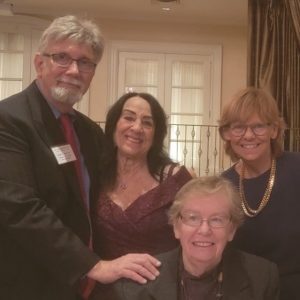 Ralph Villecca, Honey Parker, Janis L. Keown-Blackburn (seated) and Diana Dade. Diana and Janis are members of the Garden State Chapter of the Ninety Nines.
Ralph Villecca, Honey Parker, Janis L. Keown-Blackburn (seated) and Diana Dade. Diana and Janis are members of the Garden State Chapter of the Ninety Nines.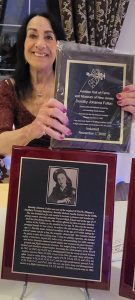 Honey Parker shows some of her sister Dorothy Fulton’s accomplishments.
Honey Parker shows some of her sister Dorothy Fulton’s accomplishments.Long overdue! And what a joyous occasion for her family! Dorothy’s younger sister, Honey Parker, worked diligently to achieve this honor for her accomplished aviator sister. Honey, her daughter Jeanne and grandson Vincent Longhitano were on hand at the ceremonies. Ralph Villecca administrator of the NJAHF introduced Honey who, in turn, introduced her sister for induction.
No pilot expects the propeller to drop off her airplane in mid-flight. But that is how, on July 10, 1938, nineteen-year-old Dorothy Fulton came to be hanging, without power, 2,000 feet in the air over populous Teaneck, New Jersey.
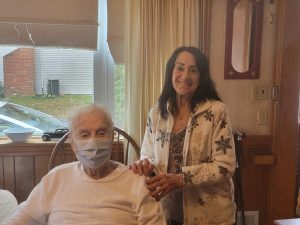 Honey Parker and Peter Jacullo, 103, one of Dorothy’s flight students before WWII. – Photos by Jeanne Longhitano, Honey’s daughter.
Honey Parker and Peter Jacullo, 103, one of Dorothy’s flight students before WWII. – Photos by Jeanne Longhitano, Honey’s daughter.“I heard the motor ‘rev’ – that means speed up,” Dorothy told reporters later than day. “I cut the switch. That’s drilled into us at school. I saw the propeller moving away from the ship. I should have been scared, but I didn’t have time. I lifted the wing so the loose propeller didn’t hit the plane. If I hadn’t, it would have torn the wing apart and I’d have crashed.
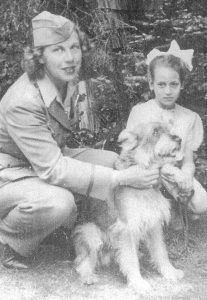 Dorothy, in her WAFS uniform, with Honey and the family dog, 1943.THE CHALLENGE: STAY IN THE AIR FOR FIVE MILES
Dorothy, in her WAFS uniform, with Honey and the family dog, 1943.THE CHALLENGE: STAY IN THE AIR FOR FIVE MILES“I dropped the nose of my plane to keep up my flying speed – eighty miles an hour. The challenge was to stay in the air for five miles, the distance to the airport.”
The crankshaft that turned the propeller had broken in midair and sheared off. That propeller actually ended up in a Teaneck, New Jersey, backyard on Bell Avenue. Dorothy managed to hold the airplane aloft long enough to make it back to Bendix/Teterboro Airport – her home base – where she landed it without further mishap. Dorothy proved her expertise in airplanes early!
In the WAFS, the C-47 became Dorothy’s signature aircraft. Stationed first at New Castle Army Air Base, Wilmington, Delaware, she was later transferred to Long Beach. She was assigned multiple times to move C-47s from one part of the U.S. to another. Usually a less-experienced copilot flew with her to gain experience under Dorothy’s capable wing.
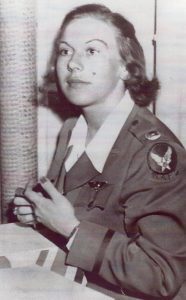 Dorothy Fulton
Dorothy FultonIn her to-date unpublished manuscript, fellow WAFS Delphine Bohn – squadron commander at Love Field, Dallas – tells this tale on Dorothy:
A BEAUTIFUL THREE-POINT LANDING!!!On a very hot afternoon, flying a very heavily overloaded Douglas C-47, Dorothy and her WASP copilot landed at Love Field to refuel. Then she made what was very nearly a turnaround takeoff on which she lost an engine too far down the runway to abort.
The tower cleared her to stay in the pattern for an immediate landing, but then she lost the hydraulic pump, which necessitated that she and her co-pilot crank down the landing gear by hand. I should point out that neither of them was a female Atlas [strongman]. It took time.
Finally, with everything down and done that was supposed to be down and done, Dorothy made a beautiful three-point landing. Mind you, this was a situation where any landing that continued upright would have been a good landing!
Delphine adds: “Over and above her normal piloting and her military-group chores, Dorothy must have made between forty and fifty twin-engine flights coast-to-coast. The woman was a patriot and a real worker, along with her many other attributes.”
The post WAFS Dorothy Fulton in NJ Hall of Fame first appeared on Sarah Byrn Rickman.
November 18, 2022
A PIECE OF WASP MILITARIZATION HISTORY
Here’s a little-known piece of WASP militarization history!
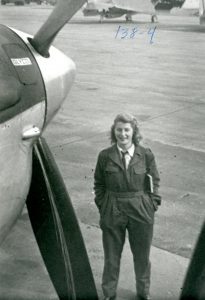 WASP Nancy Batson (Crews)
WASP Nancy Batson (Crews)Nancy Batson Crews – an original WAFS [the Women’s Auxiliary Ferrying Squadron that preceded the WASP] – served 1972-1975 as President of The Order of Fifinella , the Post-War organization established by the WASP.
During her time as president Nancy wrote a critical memorandum to all Women Airforce Service Pilots. She shared a copy of this document with this author back in 2000 when she was helping me write my first book, The Originals, the story of the 28 original WAFS (later WASP) who served in WWII. Recently, I rediscovered this document in my voluminous personal WASP archives! I’ve long known of Nancy’s early role in the WASP’s eventual militarization, but I’ve never heard anyone speak of her critical contribution. So, I am sharing the memorandum here for all to see.
Order of Fifinella Memorandum To All WASPIn 1975, Nancy wrote: The subject of WASP militarization is a matter of personal interest to all of us. It is of particular interest to those of us who joined the Reserve after the war and would like military credit for WASP time; to those of us who are Federal civil servants and would benefit from receiving veteran’s preference for job retention purposes; and for those of us who may have a need and could very well use veteran health benefits.
While there have been several separate (and valiant) efforts made by individual WASP to get Congressional approval for the item of specific application to them, I feel it is appropriate that one, coordinated and unified effort be made, under the aegis of the Order of Fifinella, with the aim of achieving veteran benefits for all. I therefore established a WASP Militarization Committee to take on this task.
General “Hap” Arnold’s son, Colonel W. Bruce Arnold, USAF (Ret) – whom you will remember was our special guest at the 30th Reunion (in Reno, Nevada) – graciously consented to chair this committee. Serving with him are WASP Faith Buchner Richards (Class 43-4), Dorothy Deane Ferguson (Class 44-9), and our Secretary-Treasurer, Mary Regalbuto Jones (Class 44-9). I will serve as ex-officio member of this committee.
“We Need Any ‘Special Influences’ You May Have”I ask each of you to give your full and enthusiastic support to this committee by being responsive to any request you may receive from them. In addition, I would like to suggest that you pass on to Colonel Arnold any information, suggestions, and any special “influences” you may have that would help the committee. [His address followed.] On behalf of the Order of Fifinella, I would like to extend our thanks to the WASP who made the initial efforts (and at their own expense) to achieve militarization/credit for military time. To those women go our sincerest thanks for breathing life into a subject most of us had all but abandoned.
Sincerely, Nancy B. Crews, President, Order of Fifinella (1972-75)
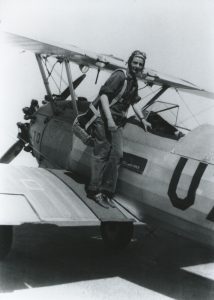 WASP Bee Falk (Haydu)
WASP Bee Falk (Haydu)It took two more years for the WASP to achieve militarization.
Bee Falk Haydu (WASP Class 44-7) followed Nancy as President of the Order of Fifinella, taking the reins in 1976. After a lot of work by the committee and the help of many WASP volunteers, President Jimmie Carter signed the WASP militarization bill Thanksgiving Day, November 23, 1977.
What An Achievement for the WASP!Author Sally VanWagenen Keil (niece of a WASP) tells this story so well in her 1979 book, Those Wonderful Women in Their Flying Machines. Chapter XV, The Battle of the WASP, explores their wartime defeat at the hands of Congress, June 21, 1944. The WASP would have to wait 33 years to see this wrong righted. Keil’s Epilogue, The Year of the WASP, tells the rest of the story – what happened in 1977. A must read!
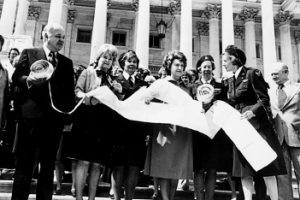 WASP VICTORY!!! Order of Fifinella President Bee Haydu, on the right.
All photos courtesy Texas Woman’s University, WASP Archives.
WASP VICTORY!!! Order of Fifinella President Bee Haydu, on the right.
All photos courtesy Texas Woman’s University, WASP Archives.
Next Wednesday, November 23 will mark 45 years since our beloved WASP were officially militarized. It was a long hard road. Only 17 WASP remain with us today to celebrate yet again what came about following Nancy’s memorandum. That’s why I wanted to share all this with you. In addition to Crews and Haydu – along with their dedicated, hard-working committee AND with Colonel Arnold’s many contributions – KUDOS to the many loyal WASP who joined in the fight for recognition, back in the day! It worked!!!
Remember the WASP and their hard-won victory on Thanksgiving Day. Add a “thank up for your service” to your “Turkey Day” remembrances.
Again, my thanks for Nancy Crews who shared this letter – and much much more – with me back in 2000.
***
Fifinella is a “sprightly feminine gremlin” created by Walt Disney and “dispatched in January 1943 to be the mascot of the 319th Women’s Flying Training Detachment,” later to be known as the WASP. She is, to this day, the official WASP mascot. – From A View From the Doghouse by Celeste Graves (who was there!), Author House, 2004.
From Sarah: Thank you for reading my blog/newsletter and thank you for reading my 12 books about the WAFS/WASP of World War II !!! You can check them out here.
The post A PIECE OF WASP MILITARIZATION HISTORY first appeared on Sarah Byrn Rickman.
November 11, 2022
VETERANS DAY: REMEMBERING WAFS DOROTHY SCOTT
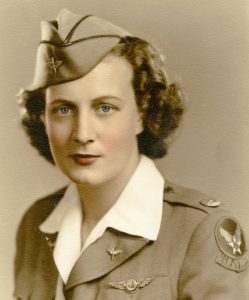 Dorothy Scott
Dorothy ScottDorothy Scott was the 25th woman pilot to join the Women’s Auxiliary Ferrying Squadron (WAFS) in the fall of 1942. Dorothy perished in a mid-air crash a year later – the second of the original WAFS to die flying for her country in World War II.
Early in 2001 as my book, The Originals – the story of the original WAFS of WWII – neared publication, there was little information about Dorothy. Then a miracle! Dorothy’s twin brother – Edward Scott – donated his sister’s stirring “wartime letters home” to the WAFS/WASP Archive, located at Texas Woman’s University, in Denton. Immediately, I flew to TWU to read her letters.
The Originals debuted in July 2001.
Years later, hoping to write Dorothy Scott’s story, I stood graveside looking down at her final resting place. This thought came to me: “What did I really know of this young woman – of her unselfish patriotism? Does that simple flat stone do justice to what she gave for her country – her life, at age twenty-three? What can do justice to such a sacrifice?” The end result was Finding Dorothy Scott, my seventh book.
In September this year, Edward Scott’s great granddaughter, Harper Scott – age 13 – wrote an essay about her Aunt Dorothy for her Language Arts class at West Middle School, Greenwood Village, Cherry Creek School District in suburban Denver. The subject was Civic Virtue.
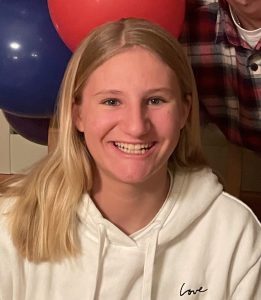 Harper Scott
HARPER’S ESSAY WON!!!
Harper Scott
HARPER’S ESSAY WON!!!
The class was due to travel to Washington DC in mid-October to visit, explore, and learn from the seat of America’s Democracy the lessons of Civic Virtue that can be absorbed there. A visit to the Tomb of the Unknown Soldier in Arlington Cemetery was on the schedule. Because of her winning essay, Harper was chosen – along with a male classmate – to present the Memorial Wreath that day.
Harper has read Finding Dorothy Scott. Not surprisingly, her great aunt’s story has had a profound effect on her. And this author is SO pleased that Harper chose to repeat those words I found to express my feelings standing at Dorothy’s grave. Thank You, Harper! You’ll see them below. Enjoy!
“What Does Civic Virtue Mean To Me?”“What did I really know of this young woman – of her unselfish patriotism? Does that simple flat stone do justice to what she gave for her country – her life, at age twenty-three? What can do justice to such a sacrifice?”
“My great-great aunt, Dorothy Scott, is the perfect example of someone who truly embodied civic virtue. During World War II, she belonged to a group of talented women called the WASP (Women’s Airforce Service Pilots). These women ferried planes across the United States allowing male pilots to travel overseas and fight in the war. Although it doesn’t seem like it, the WASP had a very dangerous job and put their lives at risk every day.
“Civic virtue means to help someone or something ‘just because’.
“People in the military selflessly serve our country to protect people they don’t even know. So, why do they? They do it because they just want to help, to feel useful. Most people serve because they enjoy it. Dorothy joined the WAFS/WASP because it was the only way she was allowed to fly and because she wanted to make a difference.
DOING WHAT SHE LOVED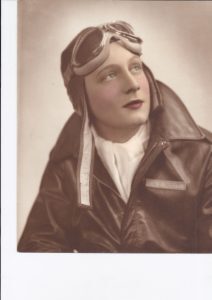 Dorothy Scott
Dorothy Scott“Her passion for aviation and desire to help others was a perfect combination for this unique position. Unfortunately, in 1943, at the age of twenty-three, Dorothy was killed in an accident at the Palm Springs airstrip when a larger aircraft landed on top of her plane. She died doing what she loved, but she also died while serving this country. Since the WASP were women, they were not considered military personnel. This group of heroic women never had the chance to be placed in a National Cemetery, let alone receive a veterans’ burial.
“As her great-great niece living in 2022, it is amazing to me that Dorothy lost her life to save others and yet our country did not acknowledge her sacrifice following the war. Finally, after THREE DECADES, Dorothy and her friends were formally acknowledged as ‘veterans’ and in 2010, received the Congressional Gold Medal, the highest award given to a civilian. But they weren’t just civilians, they served this country and were true war heroes/veterans.
“I will always admire Dorothy’s courage and determination. Every day, I carry her with me as I take risks and be the best I can be. In my academics, I work hard to achieve good grades, not expecting anything in return. Like Dorothy, I am a team player.
WHEN MY COACH ASKS, I SAY ‘YES’“When I play volleyball, I understand how important it is to work cooperatively and put others first. If a coach asks me to do something, I will always say ‘yes.’ For example, last year my coach asked me to play a position that I wasn’t familiar with, but I knew it was what my team needed at the time. In my community, I take time out of my day to say hello or hold the door open for someone and volunteer with various organizations. I believe that if every person showed civic virtue and respected others, America would be stronger than ever.
“Dorothy Scott and her fellow valiant women pilots remind us that it is important to remember ‘the debts we owe to previous generations who safeguarded our democracy’ and exemplify their civic virtue which is far too easy to forget.”
#####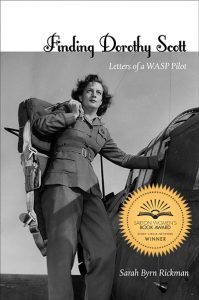
Finding Dorothy Scott: Letters of a WASP Pilot, (ISBN 978-0896729728, Hardcover)
The Air Force Historical Foundation Best Air Power History Book Award 2017Sarton Award for Biography 2016CIPA EVVY Book Award for Biography 2017Finalist for the Colorado Book Award for Biography, The Indie Foreword Book Award in adult nonfiction/history and The Willa Award in scholarly nonfiction from Women Writing the WestThank you for reading my blog and newsletter. On this Veterans Day – TODAY – in honor of Harper’s essay and of her great great aunt Dorothy. a most deserving veteran of World War II, I’m offering Finding Dorothy Scott at a special price – $25 (includes shipping) Signed by the author. Send $25 payment to paypal.me/SarahByrnRickman.
Works Cited:
Civic virtue is the harvesting of habits important for the success of a society. Closely linked to the concept of citizenship, civic virtue is often conceived as the dedication of citizens to the common welfare of each other even at the cost of their individual interests. The identification of the character traits that constitute civic virtue has been a major concern of political philosophy. The term civility refers to behavior between persons and groups that conforms to a social mode (that is, in accordance with the civil society), as itself being a foundation of society and law. – https://en.wikipedia.org/wiki/Civic_v...
Women Airforce Service Pilots and their fight for veteran status, Stephen Arionus, Air Force Personnel Center, Published Nov. 11, 2021– https://www.af.mil/News/Article-Displ...
The post VETERANS DAY: REMEMBERING WAFS DOROTHY SCOTT first appeared on Sarah Byrn Rickman.
September 16, 2022
The Passing of Queen Elizabeth II
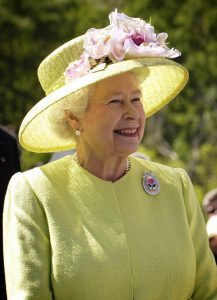 Monday all eyes will be on London, England. There, the world will say goodbye to a woman many of us have known all our lives. I speak, of course, of Her Majesty Queen Elizabeth II.
Monday all eyes will be on London, England. There, the world will say goodbye to a woman many of us have known all our lives. I speak, of course, of Her Majesty Queen Elizabeth II.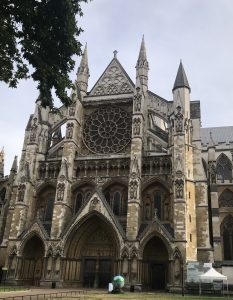
My childhood, the part I actually remember, was during the World War II years when America was involved – December 7, 1941, to August 14, 1945. I do not literally remember the day the Japanese bombed Pearl Harbor. Our family of three was in the family car headed to Tennessee. My father was taking my mother and me “home” to spend Christmas – yet three weeks away – with the larger family.
My dad traveled and my mother had bought him a car radio for company on his long, lonely drives calling on customers. They heard the announcement of the Japanese attack on Pearl Harbor over the car radio. I don’t recall hearing it, or their conversation, though I was in the backseat probably gazing out the window or asleep.
PRINCESSES ELIZABETH and MARGARET in WORLD WAR II ENGLAND!Elizabeth was a young girl of thirteen when England entered WWII on September 1, 1939. She and her younger sister, Margaret, and their parents King George VI and Queen Elizabeth became a symbol for English-speaking people and beyond. Already the Royal family had lived through the Blitz of 1940 when German bombs decimated London. For their safety from the bombing, many English children were sent away from the greater London area to the country or even abroad – many to Canada. Princess Elizabeth, with Princes Margaret at her side, spoke on the radio to these children as part of the popular English radio program, The Children’s Hour, October 13, 1940. Her talk was well received.
The presence she would carry for the rest of her life was obvious even then. You can listen to it on YouTube.
Princess Elizabeth, who turned 18 in April 1944, debated her parents for a year to let her serve in the armed forces during WWII. In February 1945, she signed on with the Auxiliary Territorial Service and served as a truck mechanic until VJ Day in May 1945. She learned to drive, kept on driving throughout her life, and taught her children and grandchildren how to drive.
A WEDDING, a BIRTH, a DEATH, a CORONATIONNot long after the war was over, love was in the air. On November 20, 1947, 21-year-old Elizabeth and Lieutenant Philip Mountbatten were married. I recall seeing photos of the wedding. Later we saw newsreel footage in the movie theater. Their first child, Prince Charles, was born November 14, 1948. Then the death of her father, King George VI in 1952, put Elizabeth on the throne at age twenty-six. Her Coronation took place at Westminster Abbey on June 2, 1953.
The morning of June 2, 1953, I set my alarm clock to go off at – I think – 4 a.m. Denver time. I awoke with a start, reached over and turned the bedside radio on and searched for the right station … KOA, the NBC affiliate. All the way from London I heard, in spite of the crackling overseas transmission, the choir of Westminster Abbey chanting Vivat, Vivat! – Latin for Long Live, Long Live! I’ve never forgotten it.
CORONATION FILMS FLOWN to NEW YORK for TELEVISION VIEWING in U.S.Live events like the Coronation were not available on television back then. Films of the Coronation soon were winging their way across the Atlantic to New York. From there, by late afternoon, the Coronation films aired on television screens across the United States. Digressing for a moment, you should know that Denver and the Rocky Mountain West did not have television for several years after the rest of the country. The problem, we understood, was the mountains.
June 2, 1953, my family did not yet have a TV set! But my friend Carolyn’s did! She invited me to come home with her after school (we were juniors at East High School) so we could watch the Coronation – in black and white!!!! Yep, color TV was still a long way off. She and I sat in her basement, our eyes glued to the screen – which by today’s standards wasn’t very big!!! But there SHE was – Queen Elizabeth II. We could watch it all unfolding majestically before our eyes! Yes! Of course, now, it is ancient history to most of the world.
SUNDAY AUGUST 28, WE STOOD on the GROUNDS of BUCKINGHAM PALACE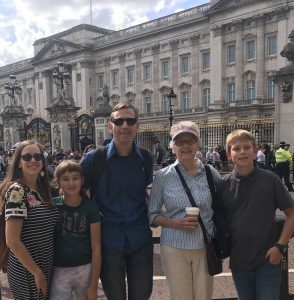 Amy, Emy, Jim, Sarah, Daniel.
Amy, Emy, Jim, Sarah, Daniel.Three weeks ago, we – my older son, daughter-in-law and two of my grandchildren – stood in front of Buckingham Palace along with thousands of other tourists and watched the ceremonial Changing of the Guard. Knowing she was away in Scotland – and not really cognizant of her health problems – I paid my quiet respects to Queen Elizabeth and wished her good health. Little did any of us know. Now a fixture in my life – and the lives of so very many – is gone.
My heritage comes entirely from Great Britain. My father was Welsh; my mother an English and Scottish mix. Though I am 100 percent American born and bred, because of my heritage and because I so greatly admired her, I have always felt Elizabeth’s reign was a part of me. Or I, a part of it. Likely many other Americans feel the same. Long Live she did. And now she is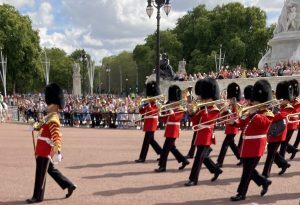 gone. Sobeit!
gone. Sobeit!
ADDENDUM: Wednesday, September 14: Watching CNN, I’m seeing the first people in line to file past and view the Queen’s coffin as she lies in state in Westminster Hall. Frankly, I am in tears. The solemn faces, the love in their eyes as they pause and bow their heads. So very meaningful. Some of the women curtsy. One woman, wearing an elegant blouse fashioned from the Union Jack, spoke outside to a reporter of her admiration and love for her Queen. So many expressed the respect and love they have for her and for her life. Watching, experiencing the quiet, orderly procession was truly moving. Respect given where respect is due.
God Bless Queen Elizabeth II! May She Rest In Peace.The post The Passing of Queen Elizabeth II first appeared on Sarah Byrn Rickman.
September 9, 2022
A SUNNY DAY IN LONDON TOWN
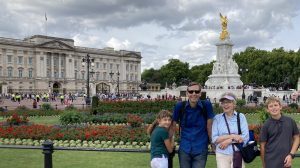 Emy, Jim, Sarah and Daniel at Buckingham Palace
Emy, Jim, Sarah and Daniel at Buckingham PalaceA full day for the Rickman Five: the Tube into downtown London deposited us near Buckingham Palace, a popular place at 11 a.m. that morning. We were there to witness the Changing of the Guard – we and several thousand other tourists. Again the “babble” of languages. I wonder if this is what the Tower of Babel was like – back in the day?
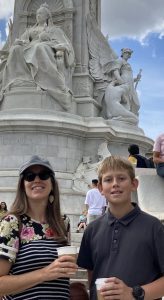 Amy and Daniel and the Queen Victoria Monument
Amy and Daniel and the Queen Victoria MonumentThe Coldstream Guards passed in front of the milling crowd. I heard the Scottish bagpipers somewhere nearby, but never saw them. Both Amy and I had seen the ceremonial ritual before, so we had let the others get well ahead of us. When it was over, we made our way back to a convenient snack bar – I for coffee, she for tea. Then I texted Jim and the kids to meet us there.
Once we were all together, we took the path over to the Victoria Monument. There, we paid homage to the much loved and admired English queen from the 19th century. Her Majesty Queen Elizabeth II was not in residence in the Palace. She was in Scotland. We paid her tribute in absentia. (Note: this was written before the Queen’s passing on Sept 8, 2022.)
 Emy and “The Eye”
Emy and “The Eye”From there, we set off for Trafalgar Square, the next stop on our walking tour of London. One thing we didn’t do was ride a red double-decker bus. Along the way, we caught views of Big Ben and of the London Eye, the famous Ferris wheel. My granddaughter Emy very much wanted to ride on it. She got her ride the next day. Gramma offered it as an early birthday present. SHE LOVED IT!!!
 Emy and Jim aloft with London spread out behind them
Emy and Jim aloft with London spread out behind themThe top-off for the day was our visit to the Churchill War Rooms. This was the underground retreat where Prime Minister Winston Churchill met with his Cabinet, “ran the war,” and often slept during the Blitz – the Battle of Britain in the fall of 1940 – and throughout World War II.
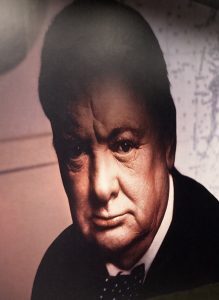 The Churchill War Rooms were opened to the public in 1984. I paid my first visit there in 1998 and it left me with a vivid memory. I recall standing in front of one of the glass-enclosed exhibit rooms – possibly the cramped quarters where the wartime cabinet met. As I stood there in the narrow hallway, over a loudspeaker came the voice of Prime Minister Churchill speaking to the British people during the Blitz. I had heard recordings of Churchill’s voice before, but this was so real. I stood there imagining being a child in London back then and listening to his voice coming over the wireless with this message:
The Churchill War Rooms were opened to the public in 1984. I paid my first visit there in 1998 and it left me with a vivid memory. I recall standing in front of one of the glass-enclosed exhibit rooms – possibly the cramped quarters where the wartime cabinet met. As I stood there in the narrow hallway, over a loudspeaker came the voice of Prime Minister Churchill speaking to the British people during the Blitz. I had heard recordings of Churchill’s voice before, but this was so real. I stood there imagining being a child in London back then and listening to his voice coming over the wireless with this message:

“We shall fight on the beaches, we shall fight on the landing grounds, we shall fight in the fields and in the streets, we shall fight in the hills; we shall never surrender.”
A few feet away stood an older woman. She was telling her grown children about hearing Mr. Churchill’s voice on the wireless in her London home during the Blitz. Fascinated, I listened intently while trying 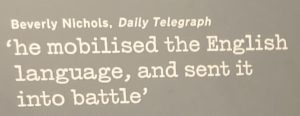 to appear to be wrapped up in the scene in front of me. I wanted to talk with her, but was concerned about intruding on her privacy and her desire to tell her family about the experience. I have NEVER forgotten that chance encounter. It brought the war – that I was so very far removed from in my childhood in distant America – so much closer.
to appear to be wrapped up in the scene in front of me. I wanted to talk with her, but was concerned about intruding on her privacy and her desire to tell her family about the experience. I have NEVER forgotten that chance encounter. It brought the war – that I was so very far removed from in my childhood in distant America – so much closer.
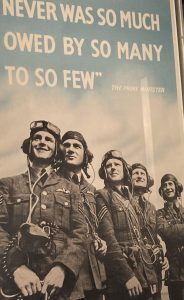
Recently, I spoke with a French-born woman – married to an American and living in the same retirement community in which I now live. She’s my age and told me that what she remembers so vividly from the war was the sound of the German boots as they marched by on the streets of Paris.
I wanted my children and grandchildren to experience the War Rooms, so I treated the five of us to a visit to the underground facility and museum. Well spent, I must say. They all enjoyed it and learned a lot from it. Tie that day in with our experience in Normandy a week earlier, and my “kids” received a WWII lesson I don’t believe any of them will ever forget.
My daughter-in-law had been to Normandy – she took her grandfather, who had served in the war in Europe – to see it. She was the prime mover in getting me there because she knew how badly I, too, wanted to visit Normandy.
My Goal – After Seeing Pearl Harbor – Was to See NormandyA work-related trip in January 1998 had taken me to Hawaii. I’ve never forgotten the day that I stood on the platform above the sunken USS Arizona in Pearl Harbor. I was staring down at the beginning of World War II for America. That day I decided that I wanted very badly to visit and see Normandy. Now that I had seen where it all began for us, I wanted to see where the beginning of the end took place.
Now, I have done it.
Stay tuned: there’s more about the Rickman’s trip to come!!!
The post A SUNNY DAY IN LONDON TOWN first appeared on Sarah Byrn Rickman.
September 2, 2022
ALL CREATURES GREAT AND SMALL
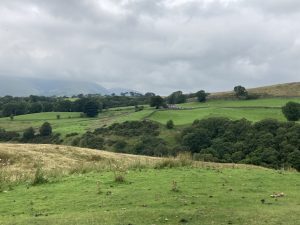 Yorkshire, England: August 23, 2022: Our search for renown veterinary surgeon James Herriot and the town of Darrowby proved futile. But if you locate the actual town of Thirsk in Yorkshire you will strike gold! The man you seek is not James Herriot, but James Alfred Wight – known locally as Alf. And he resided in Thirsk.
Yorkshire, England: August 23, 2022: Our search for renown veterinary surgeon James Herriot and the town of Darrowby proved futile. But if you locate the actual town of Thirsk in Yorkshire you will strike gold! The man you seek is not James Herriot, but James Alfred Wight – known locally as Alf. And he resided in Thirsk.
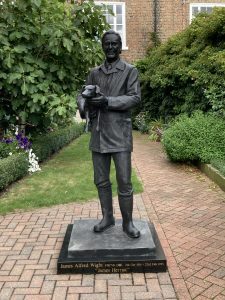 Alf Wight in the Garden at Skeldale House
Alf Wight in the Garden at Skeldale HouseAlf, a highly regarded veterinary surgeon – turned author – gave birth to James Herriot. He also created Siegfried and Tristan Farnon, Mrs. Hall, Helen Alderson, Mrs. Pumphrey and Tricky Woo, and all the other creatures, two and four-legged, who live in fictional Darrowby. In doing so, Alf captured the hearts and minds of young and old – readers and television devotees – in the British Isles as well as across the many ponds and oceans that occupy planet Earth. His books about a young vet living and working in England’s Yorkshire Dales, mid-20th century, continue to capture hearts and minds today.
JAMES HERRIOT OR JAMES ALFRED WIGHT?Alf Wight IS James Herriot. Better said, James Herriot is Alf Wight’s creation. Back in the late 1960s, Alf’s wife Joan gently suggested that all the wonderful tales of animals and their owners he had collected throughout his veterinarian life just might make good reading. She offered this sage suggestion on the occasion of his 50th birthday.
Her comments struck a chord. Not long after, Alf, budding author, wrote his first story. That story soon was joined by many more and ultimately became – through his American publisher, St. Martin’s Press – his first full volume of stories about the animals and people he encountered, All Creatures Great and Small.
In America, the TV series by that name quickly became a hit. PBS broadcast it on Sunday nights in the ’80s and ’90s. Author Johnny Byrne wrote the television series. Now, once again we can join the Herriot/Farnon fun and fray, complete with a new cast, Sunday nights on PBS. This means several new generations are being introduced to All Creatures Great and Small.
THE RICKMANS PAY DARROWBY/THIRSK A VISITLast week, August 23, my family and I visited Darrowby – uh, make that Thirsk! We five “did” the Yorkshire Dales. My son, also James, Jim for short, drove us in a British Ford Kuga. It was a far cry from the battered Austin Seven that James Herriot bounced over the rough terrain of the Yorkshire Dales, summer and winter, in daylight, and the deep, dark, dead of night.
 The Delightful Bake-Well Shop
The Delightful Bake-Well ShopUpon arrival in Thirsk, our first visit was to The Bake-Well, a delightful pastry shop where we five sat out front under an umbrella and enjoyed treats (mostly chocolate) dispensed by the delightful woman inside. We drank in the local atmosphere. We got to admire many a neighborhood dog who accompanied his or her master/mistress to the sweet shop. It made us miss our dogs back in Colorado Springs.
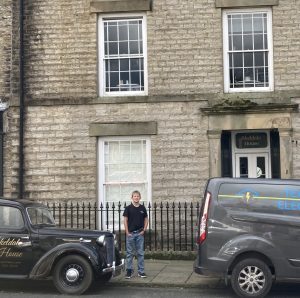 Grandson Daniel in Front of Skeldale House
Grandson Daniel in Front of Skeldale HouseThen on to the crown jewel! Skeldale House right across the street in Thirsk.
There, the World of James Herriot Museum invites you to come, partake, relish and enjoy – close up and real – the setting we’ve seen on our TV sets back home. In the hallway, three vets’ coats hang on wall hooks – overseen by the ticking grandfather clock and the 1930s-style telephone that jangles James and the others awake in the middle of the night.
HERRIOT CENTRE OPENED IN 2019The sitting room is where the three men and their five dogs relax by the warmth of the fireplace. Across the hall is the small dining room. The kitchen extends through the middle of the house. The surgery, the consulting room and waiting room are toward the back. But it was the upstairs – today the home of the “Veterinary Science Rooms” – that captivated my grandson and granddaughter. The Yorkshire Vet memorabilia room opened in June 2019 in appreciation of the benefits to the Herriot Centre, in Thirsk – Yorkshire’s Herriot Country,”
For those who truly follow and “live” the show, the “The Yorkshire Vet Room and the adjacent Interactive Gallery” offer what is as close to reality as possible of a vet’s life out on the Dales in the late 1930s. A life-size plaster horse head – its mouth open to reveal its huge teeth – invites the curious to tap each tooth to discover which one needs extraction. And then there is the plaster hindquarters of a cow, also life-size. According to the pamphlet I bought, “this provides ‘the not to be missed opportunity’ to put your hand up a cow’s bottom – an essential skill that every vet has to learn.”
DANIEL OBLIGED. I DID NOT!Actor Christopher Timothy who played James, says that he was asked repeatedly if he “actually did do it” for real in the series. In answer to the question, he took to wearing a T-shirt that said: “Yes I did.”
Life size replicas of a horse and a sow, also a sheep and a goat occupy the Yorkshire Vet Room. On display are veterinary tools and instruments, animal bones and skulls, and more. The objective is to teach children about farm animals and how they interact with our lives.
Back downstairs, we discovered the completely enclosed garden – hidden from the street by the front of the house. The setting is stunning – intensely English green with a combination of the subtler hue of the lush grass and the darker richness of the leaves on the trees. All of this is punctuated by lavender and white blossoms. A statue of Alf Wight holding a small dog in his arms is the focal point.
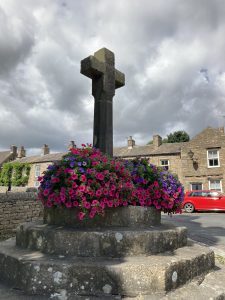 Outside St. Mary’s Church, Thirsk
Outside St. Mary’s Church, ThirskWhat better? The town of Darrowby and the delightful characters we met there some 40 years ago are back!
About Alf Wight:https://en.wikipedia.org/wiki/James_Herriot
Choosing a subject where he was more experienced, in 1969 Alf wrote If Only They Could Talk, a collection of stories centered around his experiences as a young veterinarian in the Yorkshire Dales. The book was published in the United Kingdom in 1970 by Michael Joseph Ltd. Wight followed it up with It Shouldn’t Happen to a Vet in 1972. Sales were slow until Thomas McCormack of St. Martin’s Press in New York City received a copy and arranged to have both books published as a single volume in the United States that same year. Wight named this volume All Creatures Great and Small from the second line of the hymn “All Things Bright and Beautiful“.[8]: 271 The resulting book was a huge success.
The author required a pseudonym because the Royal College of Veterinary Surgeons‘ regulations prevented vets from any type of advertising. A reliable source states that he “chose the name after attending a football match in which the Scotland internationalist Jim Herriot played in goal for Birmingham City”.[19]
*****
Thanks for reading my blog and newsletter. I hope you will sample my books about the U.S. women pilots of World War II, the WASP, as well.
The post ALL CREATURES GREAT AND SMALL first appeared on Sarah Byrn Rickman.
August 26, 2022
LONG AWAITED, A VISIT TO NORMANDY
D-Day, June 6, 1944, was a long, long time ago, but those of us who were children then, and still are around today, remember it – if only vaguely.
I was seven. I remember the headline in the Rocky Mountain News, Denver’s tabloid morning newspaper. That headline type was huge. Today I know that it was at least 84-point bold Roman type, possibly larger. I didn’t know about headline type and point sizes way back then. I would learn that much later – during my long journalism career. All I remember from back in 1944 is the type was BIG!
The same size type would be repeated 14 months later: Friday August 14, 1945 – VJ Day, the day World War II ended. … The day Japan surrendered. Germany had laid down its arms in May. The globe that is The Earth – our home – was, at long last, at peace … at least for awhile.
 Omaha Beach August 2022
Omaha Beach August 2022On August 18, 2022, our family of five set foot on Omaha Beach in Normandy, France, where American troops landed on D-Day. We explored the beach and sand dunes, the German installations on the way up the steep hill, the view of the beach from the top. To the west lay the blue Atlantic.
We walked the hallowed ground where, today, our fallen troops lie quietly.
 Overwhelming, puts it mildly. Pristine. Row and row and row upon row of white markers – the occasional Star of David standing among the crosses. Though people walk continually along the cemetery’s tree-lined path, the quiet remains, broken only by the occasional child’s cry amidst the soft murmurs of adult voices. How does one say this is the best part? But it is. This is where the reality began – and remains today.
Overwhelming, puts it mildly. Pristine. Row and row and row upon row of white markers – the occasional Star of David standing among the crosses. Though people walk continually along the cemetery’s tree-lined path, the quiet remains, broken only by the occasional child’s cry amidst the soft murmurs of adult voices. How does one say this is the best part? But it is. This is where the reality began – and remains today.
Ahead lies a tall, slender monument. Inside is a chapel erected by the United States of America:
“In grateful memory of her sons who gave their lives in the landings on the Normandy Beaches and in the liberation of Northern France. Their graves are the permanent and visible symbol of their heroic devotion and their sacrifice in the common cause of humanity.”These words grace the altar: 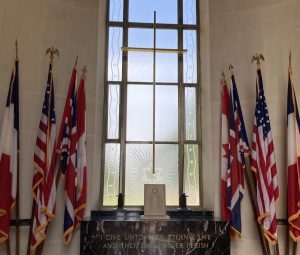
The window depicts both cross and six-pointed star.
It was the experience of a lifetime … after waiting a lifetime to see it … to be there.
[image error]
For up close and personal encounters we visited the nearby Overlord Museum. Overlord was the code name for D-Day.
There, we breathed in vivid depictions – what that day must have been like shown in living detail. A PT boat, the ramp extended, down which our GIs walked into the surf off the coast of Normandy. Some fell before reaching shore. But more came behind them and ultimately the numbers gained the shore and advanced – and kept advancing.
Tanks – German and American – Jeeps and halftracks in tableaus so real we could reach out and touch the soldiers – manikins in dirty, sweat-soaked uniforms. Unreal. Yet quickly a harsh reality to we spectators who moved slowly along the cordoned off displays. Again all ages. A babble of female, male and children’s voices.
And above it all, the Stars and Stripes, the American flag!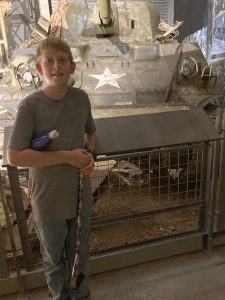 My grandson Daniel, and one of the many tanks.
My grandson Daniel, and one of the many tanks.I remember being part of the grade school color guard at Denver’s Stevens Elementary School. At 3:15 in the afternoon, seven of us marched single file to the flagpole. Standing tall – saluting properly – slowly, reverently, we lowered the precious Stars and Stripes. The pride that swelled in me all those years ago returned when I walked the beach and the cemetery in Normandy, France, August 18, 2022. It’s what America is all about.
Thank you for reading my Blog and my Newsletter, and for reading my books about the WASP – women pilots of World War II.
The post LONG AWAITED, A VISIT TO NORMANDY first appeared on Sarah Byrn Rickman.
August 12, 2022
WAFS Dorothy Fulton Honored Twice!
 Flying Over Teaneck She Loses Her Propeller!Dorothy has quite a story. No pilot expects the propeller to drop off her airplane in mid-flight. But that is how nineteen-year-old Dorothy Fulton came to be hanging, without power, 2,000 feet in the air over populous Teaneck, New Jersey.WAFS Dorothy Fulton“I heard the motor ‘rev’ – that means speed up,” Dorothy told reporters later than day in June 1939. – Yes she did get back to the airport safely. “I cut the switch. That’s drilled into us at school. I saw the propeller moving away from the ship. I should have been scared, but I didn’t have time. I lifted the wing so the loose propeller didn’t hit the plane. If I hadn’t, it would have torn the wing apart and I’d have crashed.”The only thing keeping the plane in the air was what is called “lift” – the air flowing over and under the wings at different speeds. She was faced with gliding all the way to the airport.It Was a Five Mile ‘Glide’ to Bendix-Teterboro Airport!“I dropped the nose of my plane to keep up my flying speed – eighty miles an hour. We had learned how to glide at our flight school at Teaneck High School,” Dorothy told the reporters. The crankshaft that turned the propeller had broken in midair and sheared off.“The only thing I was worried about was that it might have hit somebody. I’ve made plenty of forced landings before,” Dorothy told the reporters. That propeller actually ended up in a Teaneck, New Jersey, backyard on Bell Avenue. Dorothy did manage to hold the airplane aloft long enough to make it back to Bendix/Teterboro Airport – her home base – where she landed without further mishap.Dorothy planned to go looking for the propeller the next day, but the man who lived in the Bell Avenue house retrieved it and sent it over to the airport where he figured it belonged.Dorothy Shares Her Dream With Reporters“I want to teach kids to fly. I want to offer courses, like we have here at Teaneck High, but all over the country. I want to teach the kids who can’t afford the expensive schools – to get up in the air and handle the airplane.”World War II changed Dorothy’s plans, but she soon had the opportunity to use her well-honed flying skills for her country when it needed her. She was invited to apply for the WAFS, the Women’s Auxiliary Ferrying Squadron, the first women’s squadron to fly for the United States in the war, 1942.
Flying Over Teaneck She Loses Her Propeller!Dorothy has quite a story. No pilot expects the propeller to drop off her airplane in mid-flight. But that is how nineteen-year-old Dorothy Fulton came to be hanging, without power, 2,000 feet in the air over populous Teaneck, New Jersey.WAFS Dorothy Fulton“I heard the motor ‘rev’ – that means speed up,” Dorothy told reporters later than day in June 1939. – Yes she did get back to the airport safely. “I cut the switch. That’s drilled into us at school. I saw the propeller moving away from the ship. I should have been scared, but I didn’t have time. I lifted the wing so the loose propeller didn’t hit the plane. If I hadn’t, it would have torn the wing apart and I’d have crashed.”The only thing keeping the plane in the air was what is called “lift” – the air flowing over and under the wings at different speeds. She was faced with gliding all the way to the airport.It Was a Five Mile ‘Glide’ to Bendix-Teterboro Airport!“I dropped the nose of my plane to keep up my flying speed – eighty miles an hour. We had learned how to glide at our flight school at Teaneck High School,” Dorothy told the reporters. The crankshaft that turned the propeller had broken in midair and sheared off.“The only thing I was worried about was that it might have hit somebody. I’ve made plenty of forced landings before,” Dorothy told the reporters. That propeller actually ended up in a Teaneck, New Jersey, backyard on Bell Avenue. Dorothy did manage to hold the airplane aloft long enough to make it back to Bendix/Teterboro Airport – her home base – where she landed without further mishap.Dorothy planned to go looking for the propeller the next day, but the man who lived in the Bell Avenue house retrieved it and sent it over to the airport where he figured it belonged.Dorothy Shares Her Dream With Reporters“I want to teach kids to fly. I want to offer courses, like we have here at Teaneck High, but all over the country. I want to teach the kids who can’t afford the expensive schools – to get up in the air and handle the airplane.”World War II changed Dorothy’s plans, but she soon had the opportunity to use her well-honed flying skills for her country when it needed her. She was invited to apply for the WAFS, the Women’s Auxiliary Ferrying Squadron, the first women’s squadron to fly for the United States in the war, 1942.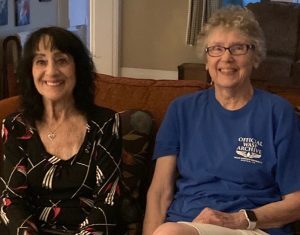 I met Dorothy’s “baby” sister, Honey Fulton Parker, back in 2004. A great, mostly long-distance, friendship began. Saturday, July 16, Honey and I “shared the stage” at the WASP WWII Museum in Sweetwater, Texas. She was the featured speaker.Honey and Sarah in SweetwaterWASP Museum Sweetwater Honors Dorothy, July 16The Museum was opening its newest exhibit, which features Dorothy Fulton. Honey was invited for the occasion. I was invited to join her because of our long-time connection through Dorothy and because of my advocacy for and writing about the WAFS. While there, the museum and I launched my new biography, Jean Landis WASP Pilot: 2,500 Miles…Long Beach to Newark in a P-51.Honey and I had a great reunion – the last time we had seen each other was in March 2010 when the WASP/WAFS were honored. They received the Congressional Gold Medal*, given to civilians. The WASP/WAFS of course, WERE civilians during WWII, receiving their much belated militarization in 1977.Honey captured our audience with tales of Dorothy’s life. Dorothy was no “shrinking violet”. She pushed boundaries, occasionally got in a bit of hot water, all the while flying the pants off any airplane the military asked her to fly. Today, they would lovingly call her a “bad ass.” Her favorite aircraft was the C-47 cargo/transport and she flew a bunch of them.Nancy Love and Her WAFS’ Achievements Often IgnoredNancy Love and her 27 WAFS and their contribution often is overlooked. All the women pilots – in August 1943 – became known as WASP. But too often the fact that Nancy Love and her WAFS came first is ignored.Dorothy Fulton and the 27 others were the “high-time” (more than 500 hours) women pilots who began flying “for their country” in October 1942, a month before the flight training school for women opened. Eventually, 1,074 more women “learned to fly the Army way” first in Houston but most of them at Avenger Field in Sweetwater where “the girls” thrived!!!I would urge you, if you are in Texas, take a trip to Sweetwater and view ALL the exhibits at the WASP WWII Museum. What a story!! And it is SO worth the effort.The Congressional Gold Medal is bestowed by the United States Congress. It is highest expression of national appreciation for distinguished achievements and contributions by individuals or institutions.Thanks for reading my blog/newsletter! Hope you’ll give my books a try.
I met Dorothy’s “baby” sister, Honey Fulton Parker, back in 2004. A great, mostly long-distance, friendship began. Saturday, July 16, Honey and I “shared the stage” at the WASP WWII Museum in Sweetwater, Texas. She was the featured speaker.Honey and Sarah in SweetwaterWASP Museum Sweetwater Honors Dorothy, July 16The Museum was opening its newest exhibit, which features Dorothy Fulton. Honey was invited for the occasion. I was invited to join her because of our long-time connection through Dorothy and because of my advocacy for and writing about the WAFS. While there, the museum and I launched my new biography, Jean Landis WASP Pilot: 2,500 Miles…Long Beach to Newark in a P-51.Honey and I had a great reunion – the last time we had seen each other was in March 2010 when the WASP/WAFS were honored. They received the Congressional Gold Medal*, given to civilians. The WASP/WAFS of course, WERE civilians during WWII, receiving their much belated militarization in 1977.Honey captured our audience with tales of Dorothy’s life. Dorothy was no “shrinking violet”. She pushed boundaries, occasionally got in a bit of hot water, all the while flying the pants off any airplane the military asked her to fly. Today, they would lovingly call her a “bad ass.” Her favorite aircraft was the C-47 cargo/transport and she flew a bunch of them.Nancy Love and Her WAFS’ Achievements Often IgnoredNancy Love and her 27 WAFS and their contribution often is overlooked. All the women pilots – in August 1943 – became known as WASP. But too often the fact that Nancy Love and her WAFS came first is ignored.Dorothy Fulton and the 27 others were the “high-time” (more than 500 hours) women pilots who began flying “for their country” in October 1942, a month before the flight training school for women opened. Eventually, 1,074 more women “learned to fly the Army way” first in Houston but most of them at Avenger Field in Sweetwater where “the girls” thrived!!!I would urge you, if you are in Texas, take a trip to Sweetwater and view ALL the exhibits at the WASP WWII Museum. What a story!! And it is SO worth the effort.The Congressional Gold Medal is bestowed by the United States Congress. It is highest expression of national appreciation for distinguished achievements and contributions by individuals or institutions.Thanks for reading my blog/newsletter! Hope you’ll give my books a try.
The post WAFS Dorothy Fulton Honored Twice! first appeared on Sarah Byrn Rickman.
July 22, 2022
Jean Landis Book Launch Takes Off
Last Saturday, July 16, the WASP World War II Museum “Zoomed” a Texas-style 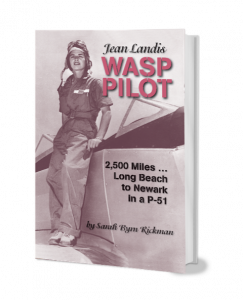 get-together down in Sweetwater! We paid tribute to an outstanding WASP – Jean Landis, Class 43-4. And we launched “her” book!
get-together down in Sweetwater! We paid tribute to an outstanding WASP – Jean Landis, Class 43-4. And we launched “her” book!
A pursuit ferry pilot, as the title says, Jean flew those swift P-51 Mustangs from the airbase at Long Beach Airport in California, to the docks at Newark, New Jersey. From there, those hi-performance fighters were shipped abroad to fight the Germans.
“I’d do it all over again in a heartbeat,” says Jean of her cherished time as a WASP in World War II.
ZOOM Book Launch Links Friends and FamilyZoom-casting from the stirring new WASP Museum itself, we in the conference room connected via a BIG screen with friends of the WASP from around the USA. They all tuned in to say “Hi” to Jean. Yes, Jean herself joined us and that made our get-together a huge success!
Jean on the wing of Chuck Hall’s modified P-51, ‘Six Shooter’ (2010)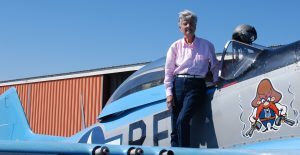 Jean, now 103, is one of the seventeen remaining WASP. She and her great nephew and his wife – Devin and Jeanne Scott – joined us from the retirement facility where Jean lives. Huge thank you’s to Jeanne and Devin for providing us with film clips of Jean from their 2010 documentary about her, She Wore Silver Wings.
Jean, now 103, is one of the seventeen remaining WASP. She and her great nephew and his wife – Devin and Jeanne Scott – joined us from the retirement facility where Jean lives. Huge thank you’s to Jeanne and Devin for providing us with film clips of Jean from their 2010 documentary about her, She Wore Silver Wings.
Also present via Zoom were a number of Jean’s relatives, young and older alike. They were a joy to see and meet and they seemed really pleased to be there celebrating with her. In addition, some of Jean’s fellow residents at the Senior facility were in attendance as well.
Jean Landis – Flight Leader, Dedicated TeacherThe story of the WASP is universal in its appeal. Jean Landis, a teacher her entire adult life – other than her twenty-two-month stint in the WASP – dedicated her life to the education of young women. Just out of college, she taught at the high school from which she graduated and, after the WASP, she taught at several different colleges. Always a leader, while in training at Sweetwater, 24-year-old Jean Landis was named Flight Leader of her class. The 112 women who graduated in class 43-4 was the largest of the eighteen WASP classes.
Jean Landis WASP Pilot is this author’s fifth book in a series of biographies of these outstanding WASP “ferry pilots”. The books are written at a level called “Young Adult” because they are intended for today’s young women who fall anywhere between the ages of 10 and 16 – necessarily a broad spectrum of reading ability and interest. But since this author refuses to write “down” to these young women, the books are good reads for adults as well. They simply aren’t as dense as adult books, as detailed or as wordy, and there is no bad language – other than the rare “damn” that is an actual quote from a WASP herself.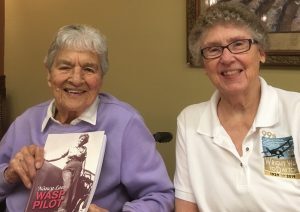
The WASP Museum Book Store there in Sweetwater is my best customer. They carry all my books – now numbering twelve. And to let you in on a secret, number thirteen is in the works!
Heartfelt Thanks to the WASP MuseumMy thanks to executive director Lisa Taylor as well as to Ann Haub and Justin Hesterly and the entire staff of the WASP World War II Museum and to my marketing manager Mary Walewski who traveled from Colorado to Sweetwater with me for this awesome book launch!!!
Hope you’ll consider reading Jean Landis WASP Pilot – 2,500 Miles … Long Beach to Newark in a P-51. I think you’ll like it!
“And thanks for reading all my WASP books.” You can see them here.
The post Jean Landis Book Launch Takes Off first appeared on Sarah Byrn Rickman.

